100th Anniversary Great Nave Tour at the Cathedral of St. John the Divine
Celebrate the 1925 construction of the stunning nave inside the world's largest Gothic cathedral!


While you wait for your train in New York City’s recently opened Moynihan Train Hall, you can entertain yourself with a trip into the past. Penn Station’s Half Century, a massive photography installation mounted on the walls of the Ticketing Room, takes viewers on a journey through nine forgotten moments in the lifespan of the original McKim, Mead, and White-designed Penn Station, which existed from 1910 to 1963. Artist Stan Douglas used a mix of live photography and computer-generated images to recreate some of Penn Station’s most iconic and little-known moments, from an impromptu vaudeville performance to soldiers and their sweethearts saying goodbye during Word War II. You can see this photography installation up-close on our upcoming walking tour, The Remnants of Penn Station, which now includes a trip to Moynihan Train Hall!
In creating Penn Station’s Half Century, Douglas aimed to “examine how history manifests in specific places and transitional moments in society.” To pick the right moments to recreate, he worked with a researcher who pored through thousands of historical newspapers. In the end, Douglas and the researcher chose nine scenes from 1914 through 1957. The individual images are arranged in thematic groups across four separate panels. To create the images, Douglas blended computer-generated settings with live staged photography. Over the course of a four-day shoot, more than four hundred actors were dressed in period costumes and posed in the various scenes. The architecture of Penn Station was digitally re-created by a visual effects studio and added in later.
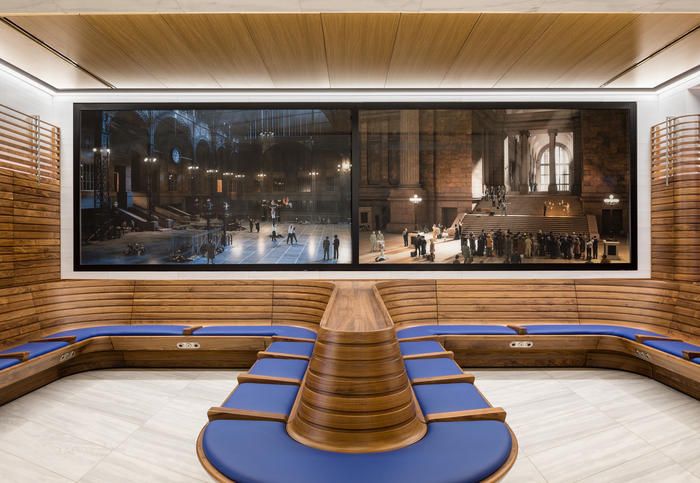
1 March 1914 and 2 March 1914, from Penn Station’s Half Century, 2020 Ceramic ink on glass. One of nine photographic panels from Penn Station’s Half Century Commissioned by Empire State Development in partnership with Public Art Fund for Moynihan Train Hall ©Stan Douglas. Courtesy of the artist, Victoria Miro, and David Zwirner. Photo: Nicholas Knight, courtesy Empire State Development and Public Art Fund, NY
The earliest scenes, which are displayed side-by-side in one panel, are pulled from the events of Sunday, March 1, 1914. On that winter day, a severe snowstorm stalled trains and left riders stuck at the station. Among the stranded travelers were various vaudeville performers. Recognizing the talent in the room, comedian and African-American movie-director Bert Williams assembled the performers for an impromptu show. Passengers stuck at Penn Station that night got to see popular acts of the time, including the Florenz Troupe, jugglers Joseph and Mary Blank, The Six Brown Brothers saxophonists, and more.
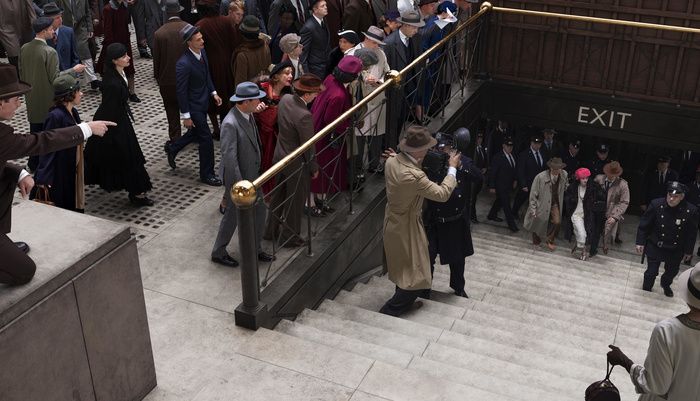
Stan Douglas, 22 April 1924, 2021. © Stan Douglas. Courtesy of the artist and David Zwirner.
Paired together in another panel are two juxtaposed images of famous figures stepping out of Penn Station. The first, from 1924, depicts bank robber and petty thief Celia Coone, known as the “Bobbed Hair Bandit.” Douglas recreated the moment Coone was captured and escorted out of the station by police through a crowd of onlookers. The accompanying scene depicts Black laborer organizer Angelo Herndon as he is led to freedom after being incarcerated for two years. A crowd of well-wishers greets him on the stairs of the station.
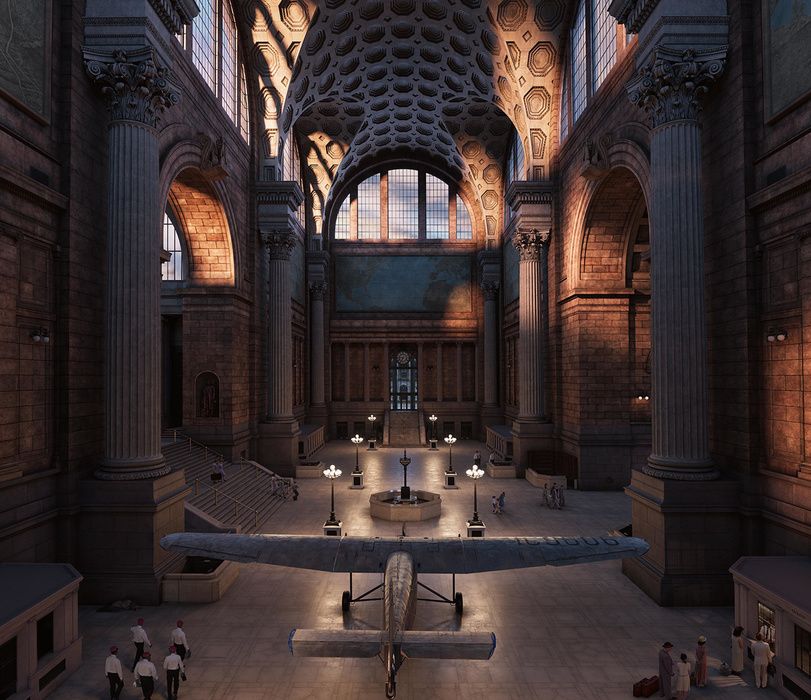
Stan Douglas, 20 June 1930, 2021. © Stan Douglas. Courtesy of the artist and David Zwirner
Another grouping of images shows the Penn Station waiting room on the morning of June 20th in three different decades. The first is set in 1930 when a Ford trimotor airplane was placed in the room to promote TWA’s new route from New York and Los Angeles. Amelia Earhart christened the airplane with a champagne bottle and led the first passengers to their train to the airport. The second image in the triptych takes viewers to 1944. At that time, the waiting room walls were covered by six oversized cutouts of a conductor, a “red-cap” porter, an engineer, a soldier, a sailor, and a marine. These forty by twenty-five-foot images funded by the Works Progress Administration called attention to the railroad’s contribution to the war effort. The final image in the panel shows the waiting room in 1957, just a few years before it was demolished, outfitted with a new ticket booth inspired by LaGuardia Airport’s sleek and modern aesthetic.
The final panel shows Penn Station as it was in the early 1940s. Penn Station was the point of departure for thousands of servicemen during World War II, making the train platforms a romantic setting for emotional goodbyes. In the accompanying image, Douglas shows Penn Station as it was recreated for Vincente Minnelli’s 1945 film The Clock starring Judy Garland and Robert Walker. For the film, a replica of the Penn Station waiting room was built on the MGM soundstage. In Douglas’ image, a handful of film crew members mill about the set, surrounded by a scattering of props and lighting equipment.
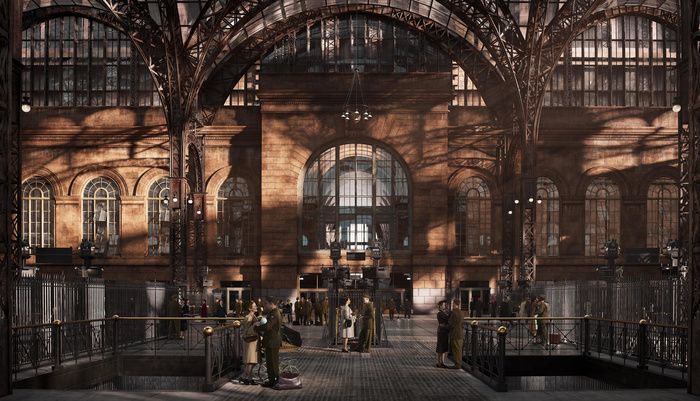
Stan Douglas, 10 November 1941, 2021. © Stan Douglas. Courtesy of the artist and David Zwirner
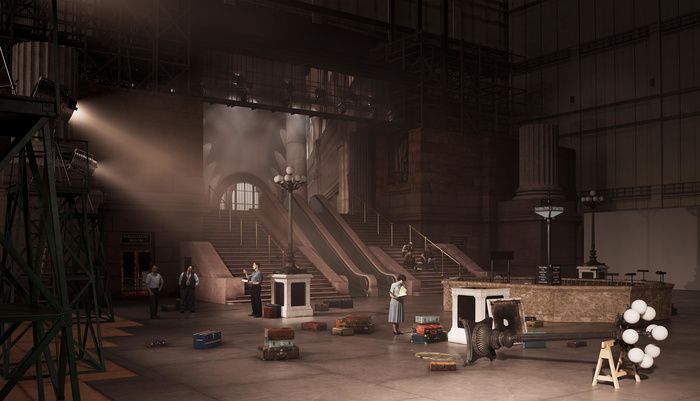
Stan Douglas, 15 September 1944, 2021. © Stan Douglas. Courtesy of the artist and David Zwirner
Douglas’s cinematic images pay homage to Penn Station’s grandeur as well as its role in the smaller moments of life. You can check out all of Stan Douglas’s images as well as behind-the-scenes photographs and video from the photoshoot in a special online gallery, Studio: Stan Douglas, hosted by the Zwirner Gallery. Check it out here!
Uncover more of old Penn Station’s history and see Douglas’ images in-person on our upcoming tour of the Remnants of Penn Station!
Next, check out See the Stunning New Public Art at Moynihan Train Hall and Moynihan Train Hall is Not Perfect, But It’s Close Enough (Op-Ed)
Subscribe to our newsletter